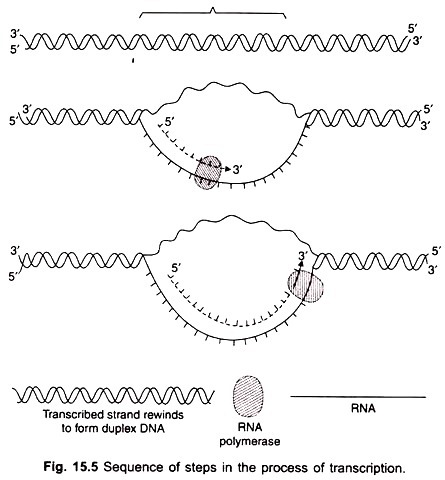ADVERTISEMENTS:
In this article we will discuss about the process of transcription.
The genetic information in the nucleotide sequence of DNA is passed on for protein synthesis through an intermediate messenger RNA (mRNA). A mRNA is a complimentary copy of one of the two DNA strands that make up a gene. The formation of an RNA copy from a DNA template is called transcription (Fig. 15.5).
Since the nucleotide sequence of mRNA is complementary to that of the gene from which it is transcribed, the information in the mRNA is identical to that in the gene itself.
ADVERTISEMENTS:
The process of transcription occurs throughout interphase and continues up to early prophase of cell division. The enzyme that catalyses DNA to RNA transcription is called RNA polymerase and the RNA molecule produced is the transcript. The chemical synthesis of RNA transcript is similar to that of DNA.
But there are following differences:
1. The RNA molecule produced in transcription is synthesised from a single strand of DNA, because in any particular stretch of DNA, usually only one strand of DNA serves as a template for RNA synthesis.
ADVERTISEMENTS:
2. The synthesis of RNA uses the four ribonucleoside 5′-triphosphates (ATP, GTP, CTP, UTP) as precursors. They differ from DNA precursors in having a ribose sugar and uracil, instead of deoxyribose and thymine.
3. The sequence of bases in the RNA molecule is complementary to the sequence of bases in the DNA template. Thus, each base that is added to the growing end of the RNA chain is selected if it has the ability to base pair with the DNA template strand. Thus, the bases T, C, A and G in DNA template result in addition of A, G, U and C respectively to the growing chain of RNA.
4. In the synthesis of RNA, a sugar-phosphate bond is formed between the 3′-hydroxyl group of one nucleotide and the 5′-triphosphate of the next nucleotide in line. The chemical bond formed is the same as in the synthesis of DNA, but the enzyme is different. Transcription uses RNA polymerase rather than DNA polymerase.
5. Nucleotides are added only to the 3′-OH end of the growing chain, with the result that the 5′ end of the growing RNA molecule contains a triphosphate group. The 5′ to 3′ direction of chain growth is identical to that in DNA synthesis.
6. RNA polymerase (unlike DNA polymerase) does not require a preformed primer to initiate chain growth.

